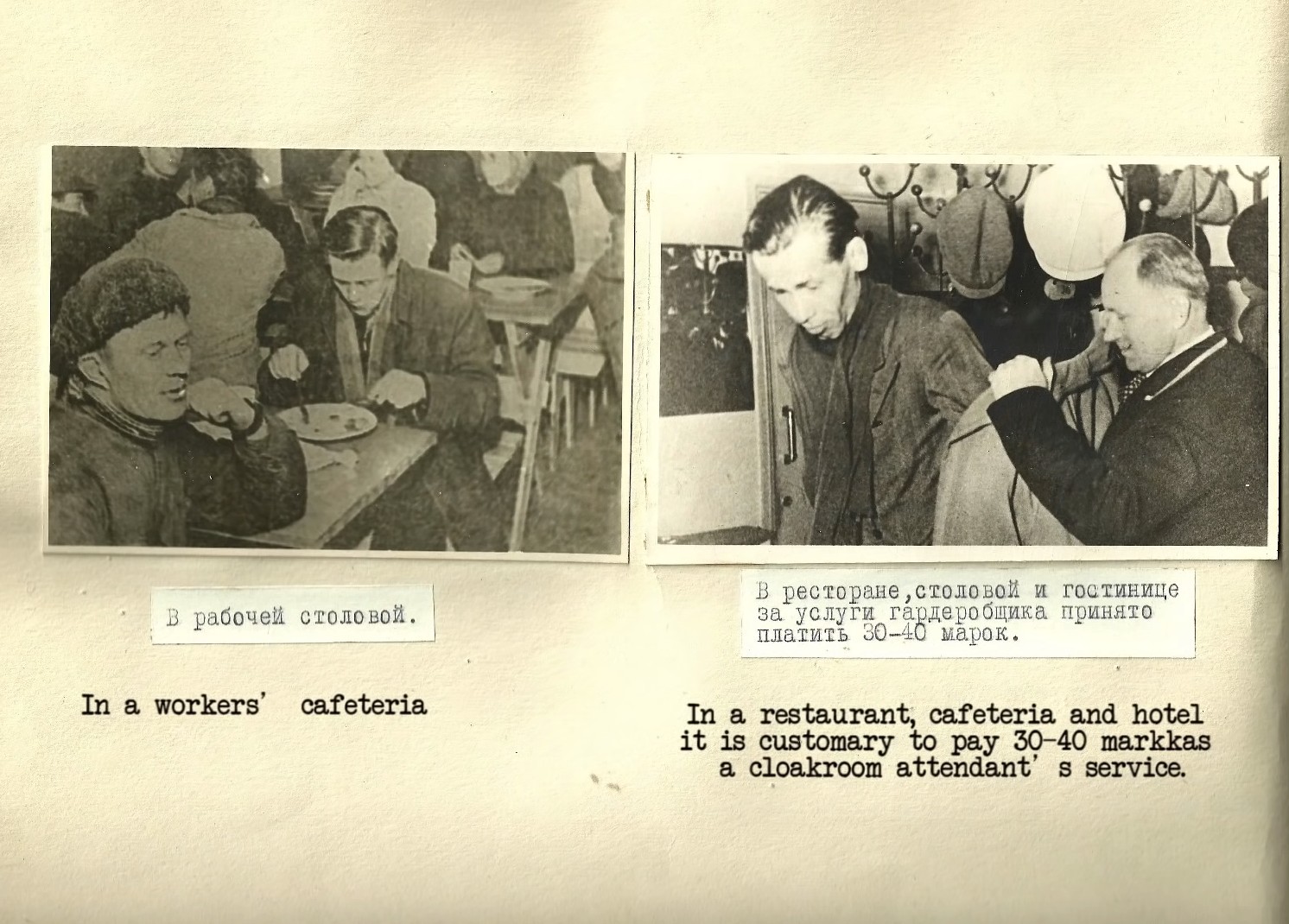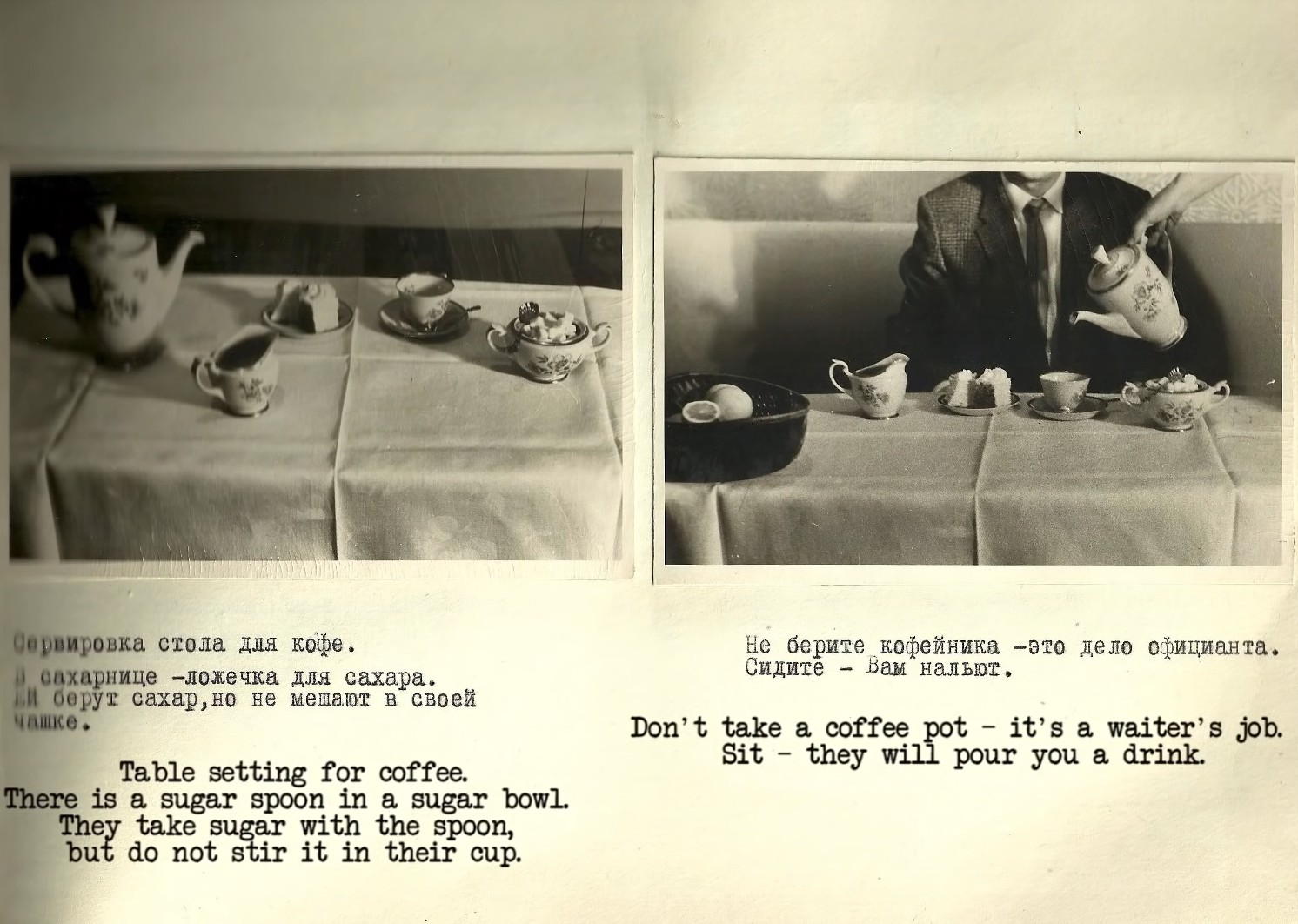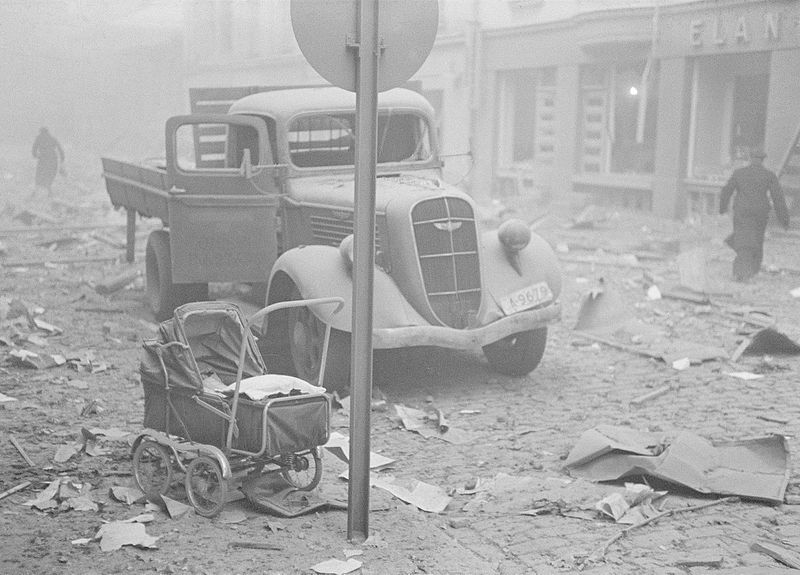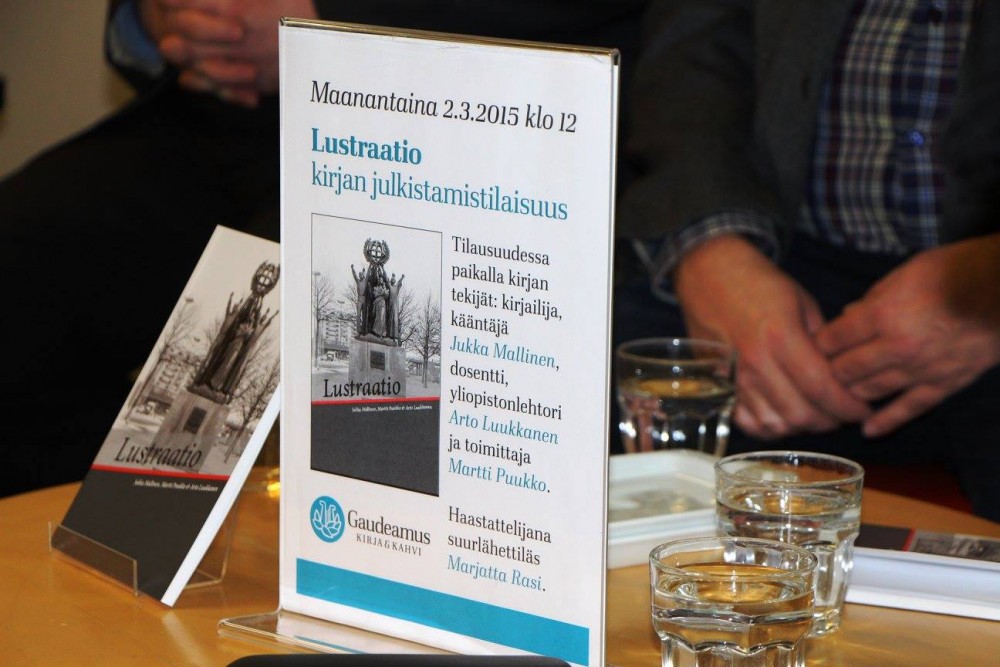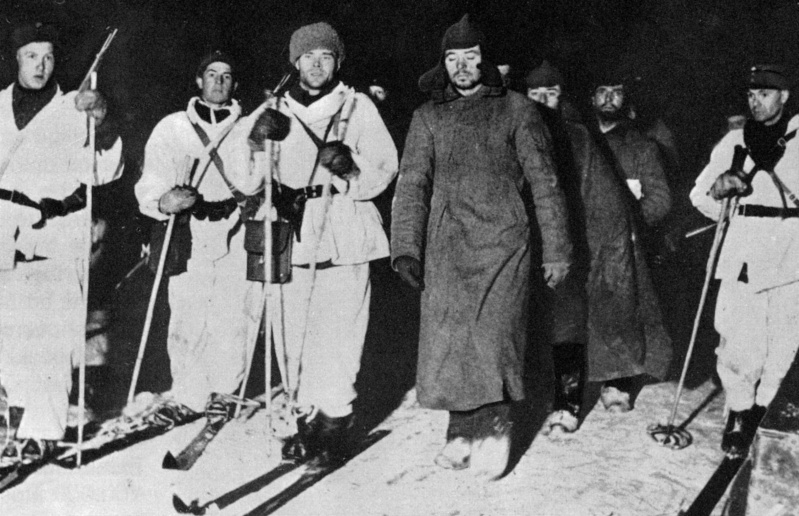First, I want to tell you a joke.
– Oh! Monsieur is a Russian spy!
– How did you recognize me? the scout asks.
– Monsieur put sugar in a cup, stirred it with a spoon, and drank with a spoon in a glass, as is done only in the Soviet Union!
Well, the next day the spy sits in another bistro and drinks tea without a spoon. But this waiter also understands who is sitting at the table. He explains that the visitor took out a spoon, but out of habit left his thumb as if holding the spoon.
Later, our officer orders tea for the third time, confident that now no one will expose him for sure. But fails again. The waiter answers the question of the discouraged spy: while drinking tea, he closes his right eye so that the spoon does not fall into it!
Many a true word is spoken in jest. A scout should know not only the language of the country he works in, but also what and how the local people eat, what they dress, what books and music they like.
(1) Eating
- Round table setting. Please note: if there are no ashtrays on the table, smoking is prohibited (this should be especially borne in mind in canteens, bars and cafes).
- Table setting for 2 persons. Knives go on the right, forks go on the left, a spoon is in front of a soup dish. A bread and butter plate is placed to the left. Pepper, mustard, salt.

- Use of a napkin – placed on the knees, but not on the collar. You can wipe your hands and lips.
- This is how they eat with a fork (do not assist yourself with a knife).
- This is how they hold a fork and knife.
- Use of a knife and fork. Cut roasts and appetizers into pieces as they are eaten, hold a small piece with the fork.
- This is how they hold the knife. The fork should be in your left hand, not on the table.
- Thus, they hold the fork, it is always in the left hand.
- Take bread with your hands, then put it on a plate on the left. A knife and fork on the left and right on the plate mean that the visitor continues to eat.
- While eating, bread is eaten with butter. Balls of butter are on a plate on the right. A ball (piece) of butter is taken with a knife, which is on the left plate, put on the bread and spread, then the knife must be put in its original place.
- Lunch – first course: soup, broth. In front there is a shared plate of appetizers. Snacks are taken as needed with a special fork or a spoon on the shared plate.
- The first course is eaten with a spoon from a plate. Often the broth is served in a special bowl with two handles – in this case, the broth is drunk like tea over the edge of the bowl (the bowl is held by the handles with both hands).
- A soup is eaten with a spoon from a plate. A broth is often served in a special bowl with two handles – in this case, the broth is drunk like tea over the edge of the bowl (the bowl is held by the handles with both hands).
- This is how a glass is held (not at the stem). Wine, vodka and other alcoholic beverages are drunk in small portions (a glass in 2-3 doses). They don’t clink glasses, they raise them to the level of their mouths and give toasts.
- After eating, the spoon and the fork are placed on the plate together, which means that the visitor has finished eating. The waitress brings the next dish.
- Cafeteria with a buffet. Lunch fee is 400-500 markkas. The visitor can choose snacks, the first, second and third courses according to their taste, eat as much as they want. Plates, knives, and forks are on the table along with snacks, a hot dish is on the stove or on another table. It is not recommended to put a lot of food on the plates, it is better to approach the table several times.
- Outdoor cafeteria. It is obligatory to take off the headgear. It is not customary to rush waiters here. Wait patiently: after all, you came here to rest.
- In a workers’ cafeteria
- In a restaurant, cafeteria and hotel it is customary to pay 30-40 markkas for a cloakroom attendant’s service.
- Table setting for coffee. There is a sugar spoon in a sugar bowl. They take sugar with the spoon, but do not stir it in their cup.
- Don’t take a coffee pot – it’s a waiter’s job. Sit – they will pour you a drink.
- Pour cream into your coffee by yourself – to taste (do not abuse cream and sugar). They drink black coffee more often.
- Sugar is taken with a shared spoon. It’s stirred with a spoon lying on a saucer by the cup. It is usual to put 2-3 sugar lumps (1 lump is equal to one-fourth of a sawn sugar piece). “Sawn sugar” is one of the common names of Soviet-made lump sugar.
- If there is no spoon or tongs on the sugar bowl, sugar is taken with hands. It is not customary to take sugar from a sugar bowl with your own spoon.
- Stirring coffee. Do not ring with a spoon, do everything quietly, do not draw attention to yourself.
- Eating а cake. It is taken with a spoon, which is used to stir sugar in a cup. On the left there is a creamer, on the right, there is a coffee pot.
(2) Clothing
- Tying a tie. Please note: the knot must be small…
- Reading a book, don’t sprawl, keep yourself humble.
- Wearing a sweater (vest) under a suit. Pay attention to the hair and mustache.
- On a sweater (jumper), all buttons are buttoned, which is not usually done while wearing a jacket.
- A sweater. It isn’t tucked into pants. A sweater is closed, but there is still a tie.
- A closed sweater (sports sweater). No tie is needed here.
- A sweater (sports sweater ). Here is a light scarf instead of a tie.
- A summer suit with two buttons. It’s usually fastened with one inner button. Flapless pockets. The trousers are narrow.
- Wearing a suit. The vest buttons are always fastened. The pocket flaps are untucked.
- A suit with a jumper (“butterfly”). Look how a pocket square is worn.
- Wearing a hat. A jacket is not buttoned.
- On a bus stop. Pay attention to people’s clothing and behavior. The usual headgear of rural areas residents is a kepi with a “stem.”
- At the market. Even being dressed in a good suit, they wear backpacks.
- Waterproof short raincoats. Shoes – with pointed toes – must always be clean. For a man, his shirt collar, cuffs and shoes are a special concern: they must always be thoroughly cleaned.
- An elongated raincoat. It is rarely worn, mostly by the elderly.
- Pay attention to wearing mufflers, gloves, and a hat. As a rule, the brim of the hat is trimmed with a braid.
- Holding a removed headgear and gloves.
- A belted coat. Wearing a scarf. Pay attention: the headgear’s top is held away from you.
- Wearing removed gloves. Pay attention to a ring. It is usually worn on the ring finger of the left hand (“the hand of the heart”).
- A demi-season coat. Look how they wear a muffler (scarf).
- A demi-season coat worn right on top of a sweater.
- A winter coat, a Pushkin hat (made of karakul)
- A winter coat with a round collar.
- A uniform of a glass factory worker.
- Peks are common footwear for Lapland residents.
- A hunter’s uniform is long rubber boots and a jacket.
(3) Infrastructure
- A tram. Get on the tram where others board, usually at the back platform. It is customary to walk on the right side of a sidewalk. You should walk slowly, waddling a little.
- A bicycle is a common form of transport in rural areas and small towns. This is how bicycles are left on the street if there are no special “stalls” for them.
- A taxi stop. A small house on the left is a toilet (the nearest entrance is for women, the farthest is for men). Signs say: NAISILLE, MIEHEILLE. This is a paid toilet. In the booth with the sign “TAKSI” there is a taxi call machine.
- A taxi stand. Follow the queue.
- A petrol station. A long distance bus. Entrance is at the back platform. Exit is at the front one. The back of the bus is a smoking area. This is easy to spot as this compartment has ashtrays embedded in the wall.
- A special tourist bus.
- A ferry. Note how bicycles and personal belongings are attached to the bus (on the roof).
- In a bus. There is a mesh shelf at the top where you can put unnecessary things: a hat, a newspaper, a magazine, gloves, etc., but not a suitcase: there is a special compartment for a suitcase at the back of the bus. Before you sit next to someone, you should ask for permission (consent).
- A stand for public messages (advertisements), next to it there is a telephone booth.
- Recreation in a garden (park). To sit down next to “couples” or women is inappropriate. It’s Better to look for free space.
- A bicycle is the main means of transportation in the countryside and small towns.
- Bicycle is the main vehicle in countryside and small towns.
- A hotel exterior. State flags of foreigners who have booked hotel rooms are hung on the building.
- A hotel room for 2 people. The price is 2500-3500 Finnish markkas. There are three call buttons in the room by the door: the 1st one is for a porter, the 2nd one is for a waiter, the 3d one is for a courier.
- A hotel room for one person. The cost is 1500-2000 Finnish markkas.
- Exterior of a Lutheran Church.
- Church service in the Lutheran church. Worshipers sit on benches with prayer books in their hands, do not cross themselves and do not bow.
Further reading:
- 10 things the KGB didn’t want you to know about Chernobyl
- They called him “Yuriy”: the KGB past of the man who advocates restoring Russia at PACE
- Moscow has increased intel ops staff by four times since 1991
- Analysis: ‘Putin isn’t a politician. He’s a spy and a provocateur’
- “I was told we should work with fascists”: former KGB officer
- The political dimension of Russia’s spy war in Ukraine
- Acquiring agents of influence – major task of Russian spy services, Khmelnytskyi says
- Putin actively using Cold War Stasi agent network in Germany, Reitschuster says
- More fallout from Ukrainian autocephaly: Russians learn Moscow Orthodox hierarchs were KGB officers
- Moscow has complex system to run agents of influence abroad, Khmelnytskyi says










